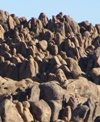|
Untitled Document
|
|
Images of Erosional Processes |
|
Images on this
site are
organized by
geologic
process, or by
locality. |
| |
Link |
Description (Click on the link or the photo to access the gallery) |
 |
Weathering |
Rocks can't be eroded and transported until they have been broken down into smaller pieces by physical weathering. Chemical weathering changes many minerals into clay and iron oxides, some of the most important elements of newly forming soils. Chemical weathering is pervasive, although it is slower in cold or dry climates. |
 |
Mass Wasting |
Any time there is a slope there is mass wasting. The process is sometimes called 'landsliding' but not all slope failures involve 'land' or 'sliding'. There may be solid rock or debris, there may be slides, falls, or flows. Whatever the material or motion, this is the process responsible for delivering material from slopes into the rivers are coastlines where the material is then transported away. |
 |
Rivers and Streams |
Rivers are a powerful force of erosion, and flooding by rivers is one of the most likely geologic hazards faced by humanity, given the location of so many cities near rivers and streams. |
 |
Karst and Caves |
Water moving underground is capable of erosion, most often via solution. Caves and cavern systems are spectacular examples of the work of groundwater. Pictures in this collection include a selection of interesting caves in California, Nevada, Montana, and New Mexico. |
 |
Glaciers |
Glaciers form when it is cold enough, and enough precipitation occurs to counter any melting that takes place. These conditions are met either in high mountains, where alpine glaciers may form, or in polar regions like Greenland or Antarctica where continental glaciers occur. |
 |
Deserts and Wind |
'Desert erosion' is not really a process; water in form of flashfloods (rivers), or mudflows (mass wasting) are the primary forms of erosion in most desert areas. But it is wind erosion (aeolian processes) that gets the attention, because wind is a more prominent process in places where the land surface is barren. But wind can't carve canyons or remove mountains. That is the work of water, even if it is not there as often. |
 |
Shorelines |
Waves are the primary form of erosion along coastlines, tearing away at cliffs and headlands and transporting sand along shorelines. Shoreline processes will demand more and more attention as the effects of global warming become more and more obvious... |
|
|
|

